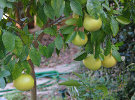Yes, Scott, technically, it does. That's what the CDFA officer told me, when I had called him about the ACP finding in Valley Center (NE San Diego county, about 20 miles east of me) about a year ago. He became very interested in my property. A little too interested, actually. Wanted to know why I had so many citrus trees. I told him I was a CRFG member and that many or more stone fruits as well, and that I am a hobbyist grower. But, that doesn't meant they'll come and spray my trees for me. I asked that question. He asked if I sold my citrus, and when I said I did not, he lost interest. Even though I told him my property backs a 147 acre abandoned Valencia orange orchard (which is being monitored, but only the northeast section, and I sit at the southwest corner of that orchard).
It is a very tough decision here in California. I try to stay as organic as I possibly can with a few exceptions. I grow my own fruit so I can control what chemicals are placed on them, because that way, I know exactly what I'm eating. And, I could try spraying very frequently (every 2 weeks) with either hort oil and/or Spinosad, but it doesn't do nearly as complete a job as Imidacloprid and other insecticides do against the psyllid. Plus, I work full time and I don't think I could keep up that kind of frequent spraying program, and during the heat of summer, I would not be able to use hort oil.
Dave, there are some very promising vector research going on right now, that are directed at control/eradication of the psyllid. Part of the problem with this psyllid is it has no natural enemies, since it is a foreign insect, so some studies have involved bringing in a couple of tiny parasitic wasps. Other research programs have been studying breeding to create sterile ACP's, thus naturally wiping out their populations. So, not so much "whistling in a graveyard", there are several other research projects going on right now, targeting the vector. Also, many being conducted targeting the bacterium as well as research projects focusing on the development of resistant cultivars. Undoubtedly, it will be a combination of several of these tactics that will eventually control or eradicate HLB and the ACP. Just a race against time here in California.
http://californiaagriculture.ucanr.org/landingpage.cfm?article=ca.v066n04p127&fulltext=yes 










